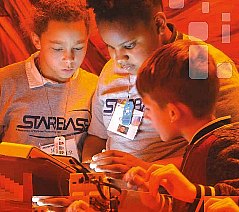
By Seth Kershner
From COMDWeb | Original Article
Beginning in 2022 the New York Times began publishing an astonishing series of investigative articles on Junior ROTC — the most sustained and critical coverage of high school militarism in recent memory. As this issue of Draft NOtices points out, the articles led to congressional action to ensure much needed oversight of high school military training. Since Junior ROTC is the crown jewel of the Pentagon’s school militarism apparatus, it’s understandable that counter-recruiters concentrate their limited resources on combating it. But a narrow focus on JROTC overlooks the many other ways the Dept. of Defense plants its flag in schools. Draft NOtices last reported on DoD STARBASE in 2015, and this article attempts to reacquaint readers with the program that annually brings militarism to nearly 80,000 elementary school students.
A Way to “Pre-recruit” Fifth Graders
The DoD STARBASE program is a transparent effort to leverage public interest in STEM education while pushing a pro-military message to ten- and eleven-year-old kids. Students participating in the program receive five days of instruction at a military base where civilian instructors offer hands-on lessons in science and engineering. One full day is reserved for uniformed members of the military to talk with students about careers in the military and give tours of their facilities.
There are numerous differences between high school JROTC and DoD STARBASE, but the biggest is that the latter program targets a much younger group of students. The different audience means that the militaristic message comes in a fun and entertaining package. One won’t find instructors screaming like drill sergeants in the DoD STARBASE classroom. Rather, it’s all friendly faces teaching lightly militaristic experiments — robots and rocketry, of course — while also providing opportunities to clamber inside a cockpit.
It’s also much cheaper compared to JROTC. Classroom space is provided gratis by the military sponsor, usually the National Guard (see sidebar). Most participating school districts are located within 50 miles of a military base, and schools are responsible only for the cost of transportation. More than three-quarters of the annual budget of $42 million, overseen by the Office of the Assistant Secretary of Defense for Manpower and Reserve Affairs, pays for teacher salaries and equipment.
What joins the two programs is their shared preference for educating low-income youth of color. Forty-nine percent of students participating in the program are Black or Hispanic while fifty-eight percent are classified in the latest DoD STARBASE annual report as “Low Income Students.” As Scott Harding and I note in an upcoming issue of the Journal of Human Rights and Social Work, students participating in DoD STARBASE represent the same disadvantaged groups historically targeted by JROTC and military recruiters.
Dark Horse of School Militarism
While public concern about JROTC increasingly makes headlines in major media outlets, DoD STARBASE has been quietly increasing its budget and its footprint in U.S. public schools.
In FY 2022, the program’s annual budget of $42,000,000 represented a 68 percent increase from FY2013. The rate of growth is even more astonishing when looking at individual states. Take the DoD STARBASE New Mexico program. Currently co-located with the Air Force Research Laboratory (AFRL) at Kirtland Air Force Base, the program has been instilling pro-military attitudes in the Land of Enchantment since 2003. As Ronda Cole Harmon, AFRL STEM Academy director, told an Air Force news outlet, they started with a single classroom, hosting just over a hundred students in their first year. They now operate three full-time classrooms and host more than ninety five-day academies to more than 2,250 students every year.
The basic fifth-grade program currently operates at 81 locations across 36 U.S. states, Guam, and Puerto Rico. Two of the newest DoD STARBASE programs, in San Luis Obispo and Porterville, California, both sponsored by the Army National Guard, will host their first groups of fifth graders in early 2024.
A Good Return on Investment
Beneath the public image of the program as an innocuous STEM enrichment tool for at-risk youth, lies the naked reality of a program designed to pre-recruit fifth graders into the military. In 2016, U.S. Defense Secretary Ash Carter called DoD STARBASE one of the DoD’s most successful outreach programs, helping “inspire kids to explore and learn more about science, technology, engineering and math. And that allows us to help them, but also allows those little kids to get to know us in a hands-on way, and we want to have more of that opportunity in both directions.”
Recent reports suggest that the Pentagon is getting a good return on its investment. To assess the effectiveness of DoD STARBASE at allowing little kids to get to know the U.S. military in a hands-on way, officials have devised a sophisticated set of pre- and post-participation surveys. Along with questions about their interests in science and technology, children are quizzed on whether they agree with statements like “Military bases are exciting” and “The military is a good place to work.” All those field trips to military bases seem to be doing the trick. An analysis of student survey responses between 2015 and 2019 found “a significant and consistent trend for students’ attitudes about the military to be positively influenced by their DoD STARBASE experiences.”
It’s also been effective at molding the minds of teachers. In 2022 surveys of educators visiting a DoD STARBASE location for the first time, more than 60 percent reported being “Extremely Likely” or “Very Likely” to recommend the military as career options to their fifth-grade students.
Outsize Impact
Although DoD STARBASE receives a smaller share of the Pentagon pie than JROTC, it continues to have an outsize impact on youth attitudes. As readers are no doubt aware, JROTC tends to be concentrated in the Southeast where public trust in the military polls at consistently higher rates than elsewhere in the country. But as a recent RAND Corporation study points out, DoD STARBASE is geographically positioned to fill in “gap areas” of the country, school districts which don’t have JROTC programs or other “sources of military influence.” The RAND analysis concluded that DoD STARBASE programs located in areas with relatively low levels of trust in the military “may be well located to create positive outreach and improve confidence in the military.”
The Pentagon takes its access to elementary schools very, very seriously. Counter-recruiters should follow suit. Due to its steady growth in recent years and its ability to tilt youth attitudes in a pro-military direction, DoD STARBASE warrants further scrutiny from activists, parents and teachers. Those wishing to monitor the program’s activities in their local communities should exploit the program’s refreshing level of transparency — hundreds of pages of detailed annual reports going back to 2018 are available online at dodstarbase.org.
Information sources:
- DoD STARBASE annual reports, 2013-2022.
- “AFRL STEM Unit Receives DoD STARBASE’s Highest Level Award,” Air Force Materiel Command, Oct. 26, 2022. Available at https://www.afmc.af.mil/.
- Harding, Scott, and Seth Kershner. “Preparing for War: Cultural & Educational Foundations of U.S. Militarism.” Journal of Human Rights and Social Work. Forthcoming.
- Wenger, J. W., Friedman, E. M., Leidy, E. N., Vasseur, M., & Leuschner, K. J. (2018). DoD STARBASE: Improved Measures for Participation, Outreach, and Impact. Rand Corporation.
__________________________________________
DoD STARBASE Facts
- The basic fifth-grade program currently operates at 81 locations across 36 U.S. states, Guam, and Puerto Rico. In FY 2022, there were a total of 3,562 five-day academies at these locations, hosting nearly 80,000 students (mostly fifth-graders) from a total of 1,558 schools in 611 school districts.
- Most DoD STARBASE programs are located on military bases, including the Air National Guard (32 locations) and Army National Guard (26 locations), but also including Air Force (11 locations), Air Force Reserve (4 locations), Army (3 locations), Navy (2 locations), and Space Force (3 locations).
- The median operating cost per location was $460,996. In FY 2022, the program’s annual budget was $42,000,000, representing a 68 percent increase from FY2013.
- History: DoD STARBASE was part of a bumper crop of school militarism programs established or expanded in the heady days after the Gulf War. In 1992, just three weeks before Congress authorized an unprecedented expansion of JROTC in the National Defense Authorization Act for FY 1993, language was included in the DoD Appropriations Act for FY 1993 to set aside $2 million for what was then called the “DoD STARBASE youth education program.”
This article is from Draft NOtices, the newsletter of the Committee Opposed to Militarism and the Draft.
